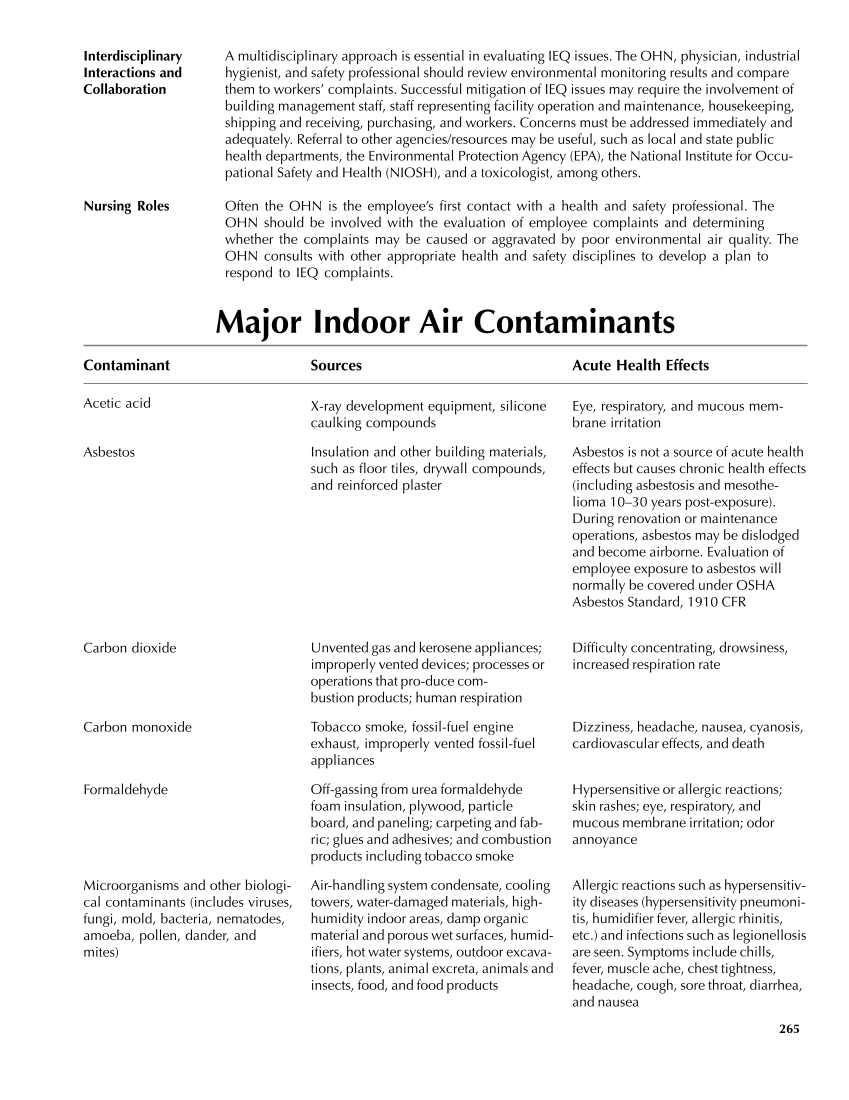A multidisciplinary approach is essential in evaluating IEQ issues. The OHN, physician, industrial hygienist, and safety professional should review environmental monitoring results and compare them to workers’ complaints. Successful mitigation of IEQ issues may require the involvement of building management staff, staff representing facility operation and maintenance, housekeeping, shipping and receiving, purchasing, and workers. Concerns must be addressed immediately and adequately. Referral to other agencies/resources may be useful, such as local and state public health departments, the Environmental Protection Agency (EPA), the National Institute for Occu- pational Safety and Health (NIOSH), and a toxicologist, among others. Nursing Roles Often the OHN is the employee’s first contact with a health and safety professional. The OHN should be involved with the evaluation of employee complaints and determining whether the complaints may be caused or aggravated by poor environmental air quality. The OHN consults with other appropriate health and safety disciplines to develop a plan to respond to IEQ complaints. Major Indoor Air Contaminants Contaminant Acetic acid 265 Interdisciplinary Interactions and Collaboration Asbestos Carbon dioxide Carbon monoxide Formaldehyde Microorganisms and other biologi- cal contaminants (includes viruses, fungi, mold, bacteria, nematodes, amoeba, pollen, dander, and mites) Sources X-ray development equipment, silicone caulking compounds Insulation and other building materials, such as floor tiles, drywall compounds, and reinforced plaster Unvented gas and kerosene appliances improperly vented devices processes or operations that pro-duce com- bustion products human respiration Tobacco smoke, fossil-fuel engine exhaust, improperly vented fossil-fuel appliances Off-gassing from urea formaldehyde foam insulation, plywood, particle board, and paneling carpeting and fab- ric glues and adhesives and combustion products including tobacco smoke Air-handling system condensate, cooling towers, water-damaged materials, high- humidity indoor areas, damp organic material and porous wet surfaces, humid- ifiers, hot water systems, outdoor excava- tions, plants, animal excreta, animals and insects, food, and food products Acute Health Effects Eye, respiratory, and mucous mem- brane irritation Asbestos is not a source of acute health effects but causes chronic health effects (including asbestosis and mesothe- lioma 10–30 years post-exposure). During renovation or maintenance operations, asbestos may be dislodged and become airborne. Evaluation of employee exposure to asbestos will normally be covered under OSHA Asbestos Standard, 1910 CFR Difficulty concentrating, drowsiness, increased respiration rate Dizziness, headache, nausea, cyanosis, cardiovascular effects, and death Hypersensitive or allergic reactions skin rashes eye, respiratory, and mucous membrane irritation odor annoyance Allergic reactions such as hypersensitiv- ity diseases (hypersensitivity pneumoni- tis, humidifier fever, allergic rhinitis, etc.) and infections such as legionellosis are seen. Symptoms include chills, fever, muscle ache, chest tightness, headache, cough, sore throat, diarrhea, and nausea
Purchased from OEM Press by (ge corporate access). (C) 2013 OEM Health Information, Inc. All rights reserved.












































































































































































































































































































































































































































